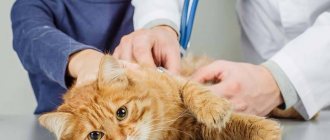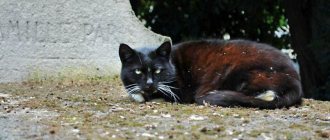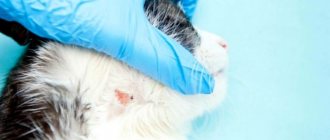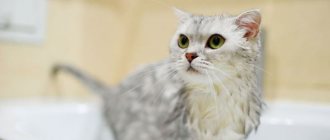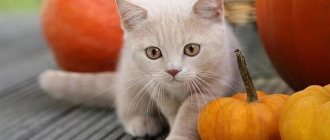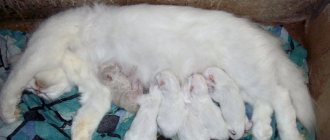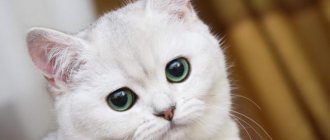Almost all owners of domestic cats periodically encounter such a not very pleasant illness as constipation in cats. Mostly older cats are susceptible to constipation, but this problem does not bypass completely healthy and young cats, and even recently born kittens.
Constipation is absent, difficult or insufficient bowel movement, which leads to a large accumulation of hardened feces in the colon, which gives the pet unpleasant and often painful sensations, and over time can lead to quite sad consequences.
Feces that are not removed in a timely manner poison the body and can lead to general intoxication , increasing the load on the excretory internal organs: stomach, kidneys, liver. Over time, progressive poisoning by decomposition products can disrupt the normal functioning of the heart and thereby lead to death.
How often should a cat go to the toilet?
In newborn kittens, the gastrointestinal tract empties 7–10 times a day.
By 1 month of age, the number of daily bowel movements is reduced to 3–6 times, and by 5 months - to 1 time. Adult representatives of cat breeds normally go to the litter box 1-2 times a day or every other day. In older animals, bowel movements are observed less frequently - once every 2-3 days. Feces in healthy animals are well formed, similar to a dense and smooth brown sausage without additional impurities. In pets that eat mainly meat, the stool has a rich dark shade. If your cat's diet contains vegetables and dairy products, the feces should be lighter in color.
Causes of constipation in cats
Before you start treating your animal, you need to find out the cause. Further actions will depend on it.
Constipation in cats occurs for the following reasons: after sterilization, when the cat is feeding kittens, when swallowing fur, after surgery, in old age, after childbirth, with a foreign body caused by parasites, with chronic diseases, with poor nutrition. Let's look at each of the reasons in more detail.
Constipation after sterilization
Veterinarians sterilize animals under anesthesia. The potent anesthetics used slow down intestinal motility. Because of this, the cat becomes constipated after surgery. As a rule, it goes away on its own. In some cases, after sterilization, the use of medications is required to restore normal intestinal function.
Constipation in a nursing cat
Every animal worries about its offspring. A cat that has recently given birth is afraid to leave the place where she lies with her kittens. Because of this, for a long time she does not go to a bowl of water and does not drink.
Lack of fluid in the body is an undesirable condition. It leads to compaction of stool and disruption of bowel movements.
Hairball constipation
Cats are clean animals. They constantly lick themselves. Each time during this procedure, pets swallow a little hair, which subsequently settles in the stomach and forms into lumps. Some of them are excreted through vomiting, while others penetrate the intestines and sometimes cause constipation.
If there is a problem with bowel movements, it is recommended to immediately consult a veterinarian. Hairballs in the intestines can cause mechanical obstruction of the gastrointestinal tract. In severe cases, surgery is necessary to save the cat's life.
Constipation after surgery
Surgical intervention may not be associated with sterilization. However, anesthesia is necessary in any case. With its help, veterinarians are able to achieve the desired effect - to put the animal to sleep and block pain sensitivity.
The medicines used have drawbacks. It lies in the fact that after anesthesia the body’s performance is impaired. All muscles weaken, including the intestinal muscles. They stop moving the contents of the organ “out”. For this reason, constipation occurs.
Constipation in older cats
Defecation problems may be associated with age. In older animals, metabolism changes and the tone of the intestinal muscles decreases.
Constipation in a cat after birth
During childbirth, a pet's hormonal levels change, and intestinal motility becomes less active. In addition, the pet loses a lot of strength during contractions and pushing. All this leads to constipation in the cat in the first days after the birth of the offspring.
After birth, it is recommended to closely monitor the condition of the animal. If the cat feels well, then there is no need to worry. If the animal is lethargic and has not had a bowel movement for more than 3 days, then you should consult a veterinarian.
Foreign body constipation
Cats often play with balls, laces, threads, and toys not intended for animals. During this process, pets often swallow small objects. This is very dangerous, because it can lead to mechanical obstruction of the gastrointestinal tract. Symptoms indicating the occurrence of this condition are vomiting and lack of stool.
If an animal has swallowed an object, it should not be given any remedies or medications. A pet can only be helped in a veterinary clinic after carrying out the necessary diagnostic procedures.
Constipation caused by parasites
The animal may not have stool due to helminthic infestation. When parasites multiply excessively, they block the intestinal lumen.
Constipation caused by stress
Cats are sensitive to stress. They often experience strong anxiety due to the arrival of strangers in the house, when a new family member (for example, a child or dog) appears, or during renovations. Due to the changed situation, the pet cannot go to the litter box in a timely manner. He endures it, and eventually constipation occurs. When the atmosphere becomes familiar, the animal calms down and stool improves.
Constipation in chronic diseases
With cholecystitis, pancreatitis, after various injuries, intestinal motility worsens. The stool becomes dry and irregular. To restore normal functioning of the gastrointestinal tract, it is not enough to eliminate chronic constipation. It is only a symptom.
First of all, diagnosis is necessary in a veterinary clinic. After conducting tests and studies, the doctor will be able to determine the pathology and prescribe appropriate treatment.
Constipation due to poor diet
With an unbalanced diet, lack of fiber, and consumption of harmful foods, problems with stool occur. Overeating can also lead to severe constipation. Due to poor nutrition, the cat gradually gains excess weight. She becomes less active and her intestinal motility slows.
A varied diet is the basis for good digestion and well-being
Poor nutrition is often the cause of constipation and other health problems. Many owners begin to feed their pets exclusively meat, such as tenderloin, or fish. Eating only dry food also has a bad effect on the predator’s body.
Try to imagine what a cat's diet looks like in the wild. She catches mice and birds and eats them whole, naturally, without choosing fillets from the prey. Meat, bones, skins, and the contents of the stomach and intestines of rodents or other animals enter the cat’s stomach. And in the intestines of the vole mouse there are semi-digested spikelets, which the cat itself cannot digest, but absorbs useful substances from them after digestion by the mouse.
The owner cannot feed the cat selected mice that have previously eaten environmentally friendly, tasty spikelets. But you can try to bring the diet closer to natural. Cats should receive not only meat products, but also grains and vegetables in a form that they can digest. People don't eat only sausage or red fish. A cat's menu should include different foods.
Treating constipation in a cat at home
It is recommended that you consult your veterinarian before giving any medication to your cat. Treatment with a laxative drug can pose a danger to the health and life of the pet, especially if the presence of hair and foreign objects in the intestines is possible.
First aid for constipation
If constipation occurs, it is best to immediately contact your veterinarian for help. The sooner the correct treatment is prescribed, the faster the cat will recover.
If it is not possible to visit a veterinary clinic, then you should try baby glycerin suppositories. They need to be inserted into the animal's anus.
Vegetable, Vaseline or castor oil
Vegetable oil is not recommended for cats. According to many experts, it negatively affects the liver and destroys its cells.
It is recommended to give Vaseline oil to a cat for constipation at the rate of 1 ml per 1 kg of weight. A safe product that is sold in any pharmacies and costs about 40 rubles. It passes through the intestines without affecting other internal organs, lubricates the walls and promotes the excretion of feces. The effect occurs in approximately 4–5 hours. If necessary, Vaseline oil can be given to the cat again. It is recommended to administer the medicine into the mouth from a syringe (without a needle, pouring the medicine into the cheek). In this case, you need to act carefully so that the animal does not accidentally choke.
Castor oil is not recommended for cats. In practice, this drug often causes severe vomiting and hemorrhagic colitis in animals.
TOP 7 laxatives
Cats are given laxatives for constipation:
- Microlax;
- Duphalac;
- Lactulose;
- Lactusan;
- Dinolak;
- Trimedat (children);
- Verakol.
Microlax is produced in the form of microenemas with a special solution. For a medium-sized pet, 2.5 ml of medicine is enough. Method of administration: introduction into the body through the anus. The positive effect occurs in about 10 minutes. In order for the laxative to have the most gentle effect on your cat, you can buy a special package with children's Microlax. Average cost – 420 rubles.
Duphalac is a tasteless syrup for oral administration. Duphalac should be given to a cat for constipation at the rate of 0.5–1 ml per 1 kg of animal weight. It has a gentle effect on the gastrointestinal tract and does not cause negative changes in the cat’s body. The approximate cost of a 200 ml medicine is 300 rubles.
Lactulose is an analogue of Duphalac, which is produced in the form of syrup. The dose for an animal is 0.5–1 ml per 1 kg of weight. The syrup can be given from a syringe or mixed with food. You can also offer medicine from a spoon. The syrup tastes sweetish. Many pets like it. Price – about 200 rubles. per bottle of 200 ml.
Lactusan is another tasteless and harmless syrup. The active substance in the composition is lactulose. The medication can be taken from a syringe, spoon, or given with wet food. Dose – 0.5–1 ml per 1 kg of weight. Approximate price – 260 rubles. per bottle of 300 ml.
Dinolak is a combination drug in the form of an emulsion for oral administration. The active ingredients are lactulose and simethicone. Under their influence, the functioning of the gastrointestinal tract is normalized in the body, the reproduction and growth of normal intestinal microflora is accelerated. The recommended therapeutic dose for a cat is 0.5 ml per 1 kg of weight. Price – about 600 rubles. per bottle of 500 ml.
Trimedat is a drug in tablet form. The active ingredient is trimebutine maleate. It regulates intestinal peristalsis and does not affect the central nervous system of the animal. The recommended dose is ¼ tablet three times a day 30 minutes before meals. The duration of the treatment course is 2 weeks. During this time, it is important to monitor your water consumption. The cat should drink at least 30 ml per 1 kg of body weight per day.
Veracol is a homeopathic veterinary remedy in the form of a solution for intramuscular or subcutaneous administration. Thanks to the natural substances in the composition, the drug gently regulates the motility of the gastrointestinal tract and has an anti-inflammatory effect. A single dose per animal is 0.1 ml per 1 kg of weight. Frequency and duration of use – from 2 to 3 times a day for 5–10 days. The exact regimen for using the medicine for constipation is determined by the veterinarian, taking into account the cat’s condition. Cost - about 300 rubles. per bottle of 10 ml.
TOP 5 cat foods for constipation
You can cope with constipation not only with the help of medications, but also with the right food. You can read more about feeding cats for constipation in this article.
Cat owners are advised to pay attention to the following foods:
- Hill's Prescription Diet i/d;
- Royal Canin Gastrointestinal Fiber Response;
- Pro Plan Veterinary Diets En St/Ox Gastrointestinal;
- Eukanuba Intestinal;
- ShinyCat.
Hill's Prescription Diet i/d is a dietary medicinal food that is easy to digest and assimilate. The product is enriched with a mixture of prebiotics. Thanks to this, it maintains the health of the digestive system, improves stool and gastrointestinal function. Cost – about 170 rubles. for a 156 g can and about 90 rubles. for 1 bag of wet food weighing 85 g.
Royal Canin Gastrointestinal Fiber Response is a complete dry food. It contains quite a lot of fiber. It is thanks to this that optimal quality of the cat’s stool is achieved. Diet therapy can last 3–4 weeks. However, the exact duration of the course must be determined by a veterinarian. In some cases, long-term use of the feed may be recommended. Price – about 550 rubles. for a package weighing 400 g and about 2.3 thousand rubles. per bag of 2 kg.
Pro Plan Veterinary Diets En St/Ox Gastrointestinal – food for a veterinary diet. It is indicated for disorders of the gastrointestinal tract in animals of any age. Contains prebiotics (inulin) to promote intestinal health. The amount of protein is limited, due to which unwanted gastrointestinal reactions are minimized. Cost - about 80 rubles. for a pack of wet food and 1.3 thousand rubles. for a package of dry food weighing 1.5 kg.
Eukanuba Intestinal is a dry and wet food with fiber, a therapeutic line for eliminating digestive disorders. The product contains easily digestible ingredients, essential fatty acids, and natural fiber. Cost - about 60 rubles. for a pack of wet food and about 1 thousand rubles. per bag of dry food weighing 1.5 kg.
ShinyCat product line, wet food with tuna and grass deserves attention. The product is rich in proteins, fiber, and contains a moderate amount of fat.
How to give an enema for constipation in cats
An enema should only be given as prescribed by a veterinarian. In other cases, the procedure can be dangerous for the animal, because constipation can mask dangerous pathological conditions.
If an enema is prescribed by a doctor, you can administer it yourself at home.
To give your cat an enema, you will first need to prepare a solution:
- pour 200 ml of boiled water into a container;
- heat it to 30 °C;
- add vaseline oil in a volume of 20 ml;
- stir to obtain a homogeneous emulsion, but do not foam.
Next, it is recommended to wrap the cat in a towel, draw the volume of product prescribed by the veterinarian into the syringe, release excess air, lubricate the tip with Vaseline and carefully insert it into the animal’s anus. After this, it is important to slowly pour the liquid into the intestines.
The cat should be restrained for 10–15 minutes after the procedure. After this time, the animal must be released into the tray.
How to give a massage if your cat is constipated
Cats who are constipated often feel pain. As a rule, they do not allow their owners to touch their belly. If the animal does not resist, then you can massage it - stroke the fur with a warm palm. This measure calms and reduces pain.
Changing your diet
A cat is a carnivore, so its diet should be based on protein-rich meat. However, this is not enough for healthy digestion. The animal needs indigestible fiber. In a natural diet, the source of this component can be carrots, wheat bran, and potatoes. For those who feed animals with industrial feed, there are special dietary lines of products with a high fiber content.
TOP 5 folk methods for constipation in cats
If you have a question about what to give your cat for constipation, you should pay attention to simple folk remedies:
- Kefir. It can help with mild constipation. The main properties of the product are that it normalizes digestion and maintains the balance of intestinal microflora.
- Condensed milk. Recommended dose – 1 tsp. for 1 time. This product should not be abused. It contains sugar, and sweets are contraindicated for animals. If you ignore this recommendation, your cat may develop diabetes.
- A decoction of flax seeds. For cooking you need 1 tsp. product pour 3 tbsp. l. boiling water and leave for 10–15 minutes until mucus forms. Strain the broth, squeeze it out and give it to the cat 20 minutes before meals.
- Pumpkin. The vegetable is rich in soluble and insoluble fiber. It is recommended to add it to the food of cats on a natural diet. 1-4 tbsp is enough. l.
- Wheat or oat bran. This product is also intended to be added in small quantities to food. Once in the gastrointestinal tract, it acts as a brush and removes feces.
Treatment of constipation in a cat in a veterinary clinic
Treating constipation in a cat begins with diagnostic procedures. Doctors in a veterinary clinic conduct x-rays, ultrasound examinations, and take blood samples for analysis. The results obtained allow us to find out the exact cause of constipation.
The next steps depend on the diagnosis. If a foreign body is detected, surgical intervention is prescribed. If your cat's constipation is caused by fecal buildup, veterinarians will give an enema. If necessary, any medications can be administered - to relieve the inflammatory process, treat the liver, restore normal functioning of the gastrointestinal tract, etc.
Diagnostics
If the problem is long-term and treatment at home does not work, you need to contact a veterinarian. Usually, an examination and interview with the owner is enough to diagnose the animal.
If a foreign body is suspected, improper bone healing after a fracture, tumor, narrowing of the intestine, protrusion of the rectal wall, a manual examination of the rectum is performed.
In case of frequently recurring cases of constipation, laboratory tests are carried out to exclude diseases of internal organs and systems.
Prescribed:
- Clinical analysis of blood and urine.
- Study of thyroid function.
- X-ray of the abdominal cavity (to detect tumors, foreign bodies, fractures).
- If a tumor is suspected, ultrasound of the abdominal cavity and biopsy.
Preventing constipation in cats
For prevention, it is recommended to give prebiotic supplements. If you follow the instructions for use, they are harmless to the animal.
One example prebiotic supplement is Viyo Reinforces. It consists of inulin and fructooligosaccharides. With its help you can improve the functioning of the gastrointestinal tract. When prebiotics enter the body, they increase the number of beneficial bacteria and strengthen the immune system. The additive also has several additional properties - it prevents urolithiasis, makes the coat healthy and shiny. The product is easy to use. They just need to water them with the pet’s usual food. Cost – about 500 rubles. per pack of 7 sachets.
Another prebiotic feed additive is Vetelact. The product normalizes metabolism in the gastrointestinal tract, restores beneficial microflora, activates the immune system, and eliminates constipation. The drug is especially useful during antibiotic therapy, because with the help of Vetelakt you can prevent the occurrence of dysbiosis. Cost - about 150 rubles. per bottle of 20 ml.
Other preventive measures for constipation in cats:
- If the cat has long hair, then it needs to be brushed periodically. With this simple measure you can prevent the ingestion of some fur.
- It is recommended to regularly give the animal cleansing phytomins. They are usually produced in the form of paste or tablets. These products will help remove hair, relieve inflammation, and normalize the gastrointestinal tract.
- It is important that your cat drinks enough water daily. If the animal refuses to drink, it must be given water from a syringe. It is also worth paying attention to the special fountains that are on sale. Of these, cats drink more readily.
And another important factor is movement. An active lifestyle can prevent constipation and improve intestinal motility. In order for the animal to move more, it is worth buying various small toys or play complexes for it.
General information
But first you need to understand what constipation is. This is the name of a pathological condition in which formed feces are not excreted from the animal’s body.
And the reasons for this phenomenon are extremely diverse.
But all of them can be divided into three large groups:
- Constipation caused by some foreign body in the lumen of the large intestine.
- Pathologies that arise due to compression of the intestines from the outside (i.e. from the abdominal or pelvic cavities). Adhesions, poorly healed fractures, benign or malignant tumors are usually to blame.
- Finally, constipation of functional origin. They develop due to dehydration, decreased peristaltic activity of the digestive system and similar factors. The case we describe can be attributed precisely to this group.
Constipation in the postoperative period can be acute or chronic. The first type develops quickly, suddenly, the animal cannot defecate at all. Chronic constipation develops gradually and at first is expressed only in slight difficulty in defecation. Note that acute stool blockage in the postoperative period is more “physiological,” while the chronic type may be a sign of adhesions and other severe pathologies.
The symptoms of the pathology are very similar in all cases: the pet constantly runs to the litter box, sits for a long time, strains, meows loudly, but cannot relieve itself.


